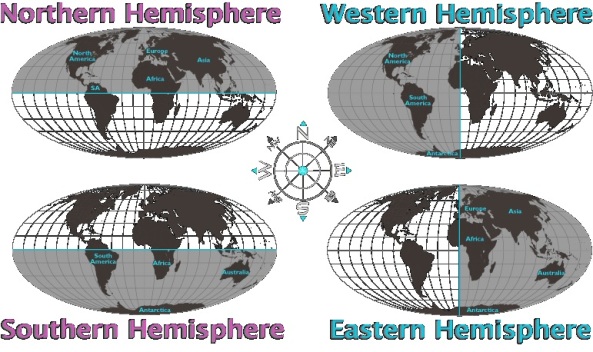The planet’s four hemispheres are each shaded a dark gray.
The Equator, that imaginary horizontal line at 0º degrees latitude at the center of the earth, divides the earth into the Northern and Southern Hemispheres.
The vertical imaginary line called the Prime Meridian, at 0º degrees longitude, and its twin line of longitude, opposite the Prime Meridian at 180º longitude, divides the earth into the Eastern and Western Hemispheres.
Therefore (with some exceptions) all countries north of the Equator are in the Northern Hemisphere, while all countries south of the Equator are in the Southern Hemisphere. In addition, all countries west of the Prime Meridian are in the Western Hemisphere while those east of the Prime Meridian are in the Eastern Hemisphere.
Generally the Eastern Hemisphere includes most of Africa, about half of Antarctica, all of Asia and Australia/Oceania, and most of Europe.
The Western Hemisphere includes about half of Antarctica and all of North and South America which includes the Caribbean and Central America as well as Greenland.
The Northern Hemisphere includes all of North America, the northern reaches of South America, about two-thirds of Africa, all of Asia excluding (parts of Indonesia) and all of Europe.
The Southern Hemisphere includes most of South America, one-third of Africa, all of Antarctica, a small sliver of Asia (parts of Indonesia) and all of Australia/Oceania.
There are exceptions as some continents (and their countries) based on the straight line divisions of the Equator and Prime Meridian are a part of two hemispheres. For a map and list of countries in both the Eastern and Western Hemispheres, go here, and for countries in both the Northern and Southern Hemispheres.

#SaveTheTurtles
LikeLike
save the turtles
LikeLike
Come on now, I know not much of Africa is in the Western Hemisphere, but you did not mention it at all. Big omission there folks Be more careful in the future please.
LikeLike
No you
LikeLike
i cannot find anything
LikeLike
What are the coordinates to the
LikeLike